10 July 2018
Scientists discover “ghost dunes” on Mars
Posted by llester
The crescent-shaped pits could help researchers understand the Red Planet’s past climate
By Liza Lester
Scientists have discovered hundreds of crescent-shaped pits on Mars where sand dunes the size of the U.S. Capitol stood billions of years ago. The curves of these ancient dune impressions record the direction of prevailing winds on the Red Planet, providing potential clues to Mars’s past climate, and may hold evidence of ancient life, according to a new study detailing the findings in the Journal of Geophysical Research: Planets, a publication of the American Geophysical Union.
Ghost dunes are the negative space left behind by long-vanished sand dunes. Lava or water-borne sediments partially buried the dunes and hardened, preserving the dunes’ contours. Wind subsequently blew sand off the exposed tops and scoured it out from inside, leaving a solid mold in the shape of the lost dune.
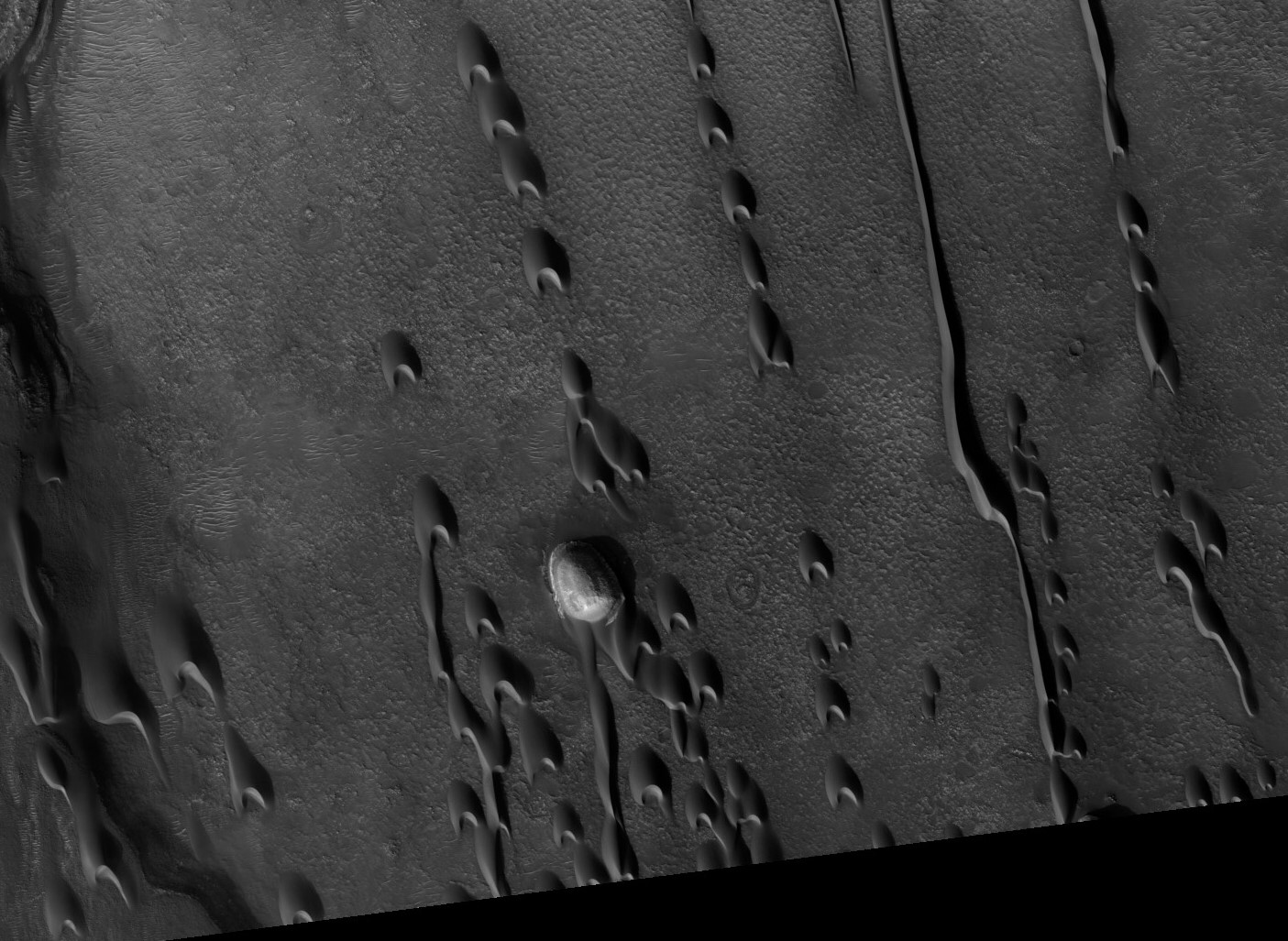
Barchan dunes march across a plain in the Hellespontus region, west of Hellas basin, on Mars. The orientation of their horns indicates consistent winds out of the east, blowing top to bottom in this image captured by the Mars Reconnaissance Orbiter. Sunshine lights the steep slopes of the leeward, or downwind, faces, on the dunes’ lower sides. The dunes migrate with the wind, sometimes merging or extending long fingers that spawn new dunes.
Credit: NASA/JPL/University of Arizona
Ghost dunes were first discovered on Earth on the Snake River Plain in eastern Idaho in 2016. The new study identified similar ghost dunes in satellite images of Hellas basin and Noctis Labyrinthus on Mars. Dunes are a common feature on the wind-blown surface of the Red Planet, but the new study is the first report of preserved dune casts on Mars.
“Any one of these pits is not enough to tell you that it’s a dune, or from an ancient dune field, but when you put them all together, they have so many commonalities with dunes on Mars and on Earth that you have to employ some kind of fantastic explanation to explain them as anything other than dunes,” said Mackenzie Day, a planetary geomorphologist at the University of Washington in Seattle and an author of the new study.
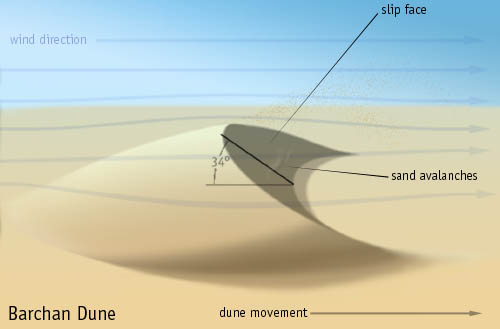
Source: Wikipedia CC BY-SA 3.0
“One of the cool things about the ghost dunes is that they tell us, for sure, that the wind on Mars was different in the ancient past, when they formed,” she said.
The atmosphere at the surface of Mars is about as dense as Earth’s stratosphere 35 kilometers (22 miles) above sea level, yet wind is a persistent agent of change sculpting the surface.
Understanding the winds of the past can help researchers reconstruct how sediments could have traveled over the surface, how major features formed and if the ancient climate differed from modern atmospheric conditions, Day said.
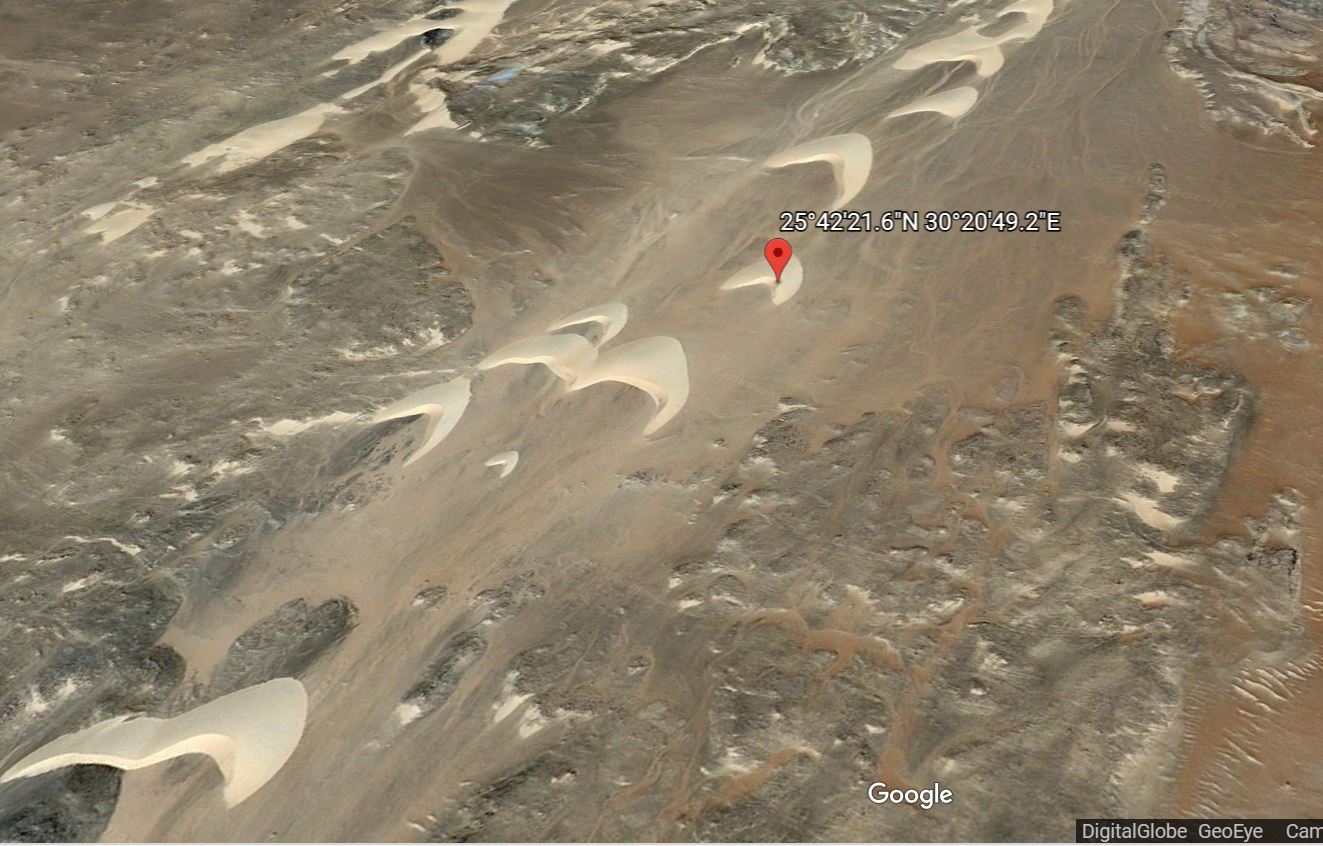
The horns of barchan dunes indicate prevailing winds out of the north (top) in Egypt’s Western Desert near Kharga (25.706⁰, 30.347⁰).
Credit: Google Earth.
“The fact that the wind was different [when the ghost dunes formed] tells us that the environmental conditions on Mars aren’t static over long time scales, they have changed over the past couple billion years, something we need to know to interpret the geology on Mars,” she said.
Familiar shapes inverted
Using satellite images, Day and co-author David Catling, an astrobiologist at the University of Washington, documented more than 480 potential dune molds at the pit field at Noctis Labyrinthus, a fractured jumble of plateaus on the equator just west of Valles Marineris, the largest canyon system in the solar system. The researchers also found more than 300 crescent-shaped pits in a smooth, low-lying surface in eastern Hellas Planitia, an enormous, 4-billion-year-old impact crater stretching over 2,700 kilometers (1,678 miles) across Mars’s southern hemisphere.
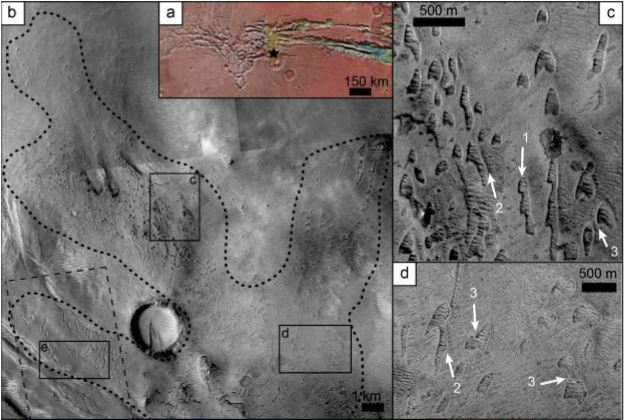
A field of dune cast pits (panel b) was found at Noctis Labyrinthus, just west of Vallis Marinaris at the black star in panel (a). Close-ups of the pits in panels (c) and (d) show pits in the crescent shapes of barchan dunes. The outlines of chains of calving dunes, dunes with elongating arms and the characteristic forms of collision with other dunes, much like the live dunes at Hellespontus, are preserved by the pits.
Credit: Mackenzie Day and David Catling/ AGU
The pits bear a striking resemblance to barchan dunes, the most common dune type on Earth and on Mars. Crescent-shaped barchan dunes form on flat surfaces, unimpeded by vegetation, when wind blows mainly from one direction and sand is limited. The horns of the crescents point in the direction of the prevailing wind. Sand accumulates on the outside of the bow of the dune, blows over the lip and avalanches down the steep slipface on the inside curve of the dune.
The size and shape of the pits is consistent with active dune fields on Mars, and the pits have characteristics only found in dunes, Day said. A single crescent pit might be a curious anomaly, Day said, but a set of pits, aligned like croissants on a baker’s tray, looks like a dune field. Congruity helped support the hypothesis that the pits are the remains of ancient dunes.

Ghost dunes were first discovered on Idaho’s eastern Snake River plain (111°36’11.06″W, 44° 4’54.20″N) by David Gaylord in 2015.
Credit: Google Earth
“They are all going the same way, which you would expect for dunes because they are all migrating and forming in the same wind regime. So just the shape and size tell us that these are features that are coming from an ancient dune system,” Day said.
Based on comparisons with lives dunes, Day calculated the average dune stood about 40 meters (130 feet) tall at Noctis Labyrinthus and 75 meters (246 feet) tall at Hellas basin at the time they were buried.
Ancient landscapes
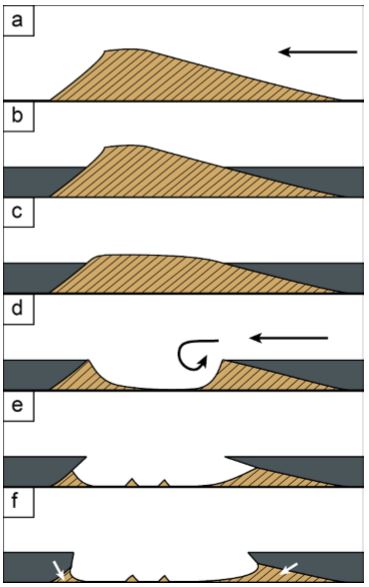
Creation of a ghost. (a) Barchan dunes form with their steep faces away from the prevailing wind, indicated by the black arrows. (b) A slow-moving liquid – lava in the case of the Snake River ghost dunes on Earth, but possibly muddy water in other instances – flowed in around the dunes and buried them halfway up their flanks. The lava or sediment hardened to rock. Wind blew away the exposed sand (c) scouring it from below the level of the rock. Recirculating winds further undercut sand from the edges of the hard deposit (e) which erodes widening the pit (f). Ancient sand may linger in the deep crevices of the pits, protected from radiation and the eyes of orbiting satellites.
Credit: Mackenzie Day and David Catling/ AGU
Day and Catling estimated the inundation of the ghost dune fields on Mars occurred in the late Hesperian or early Amazonian period, about 2 billion years ago, assuming it is consistent with the smooth surface between the dune pits. That smooth surface likely began as a slow-moving liquid that poured into the dune field, rising 6 meters (20 feet) around and between the feet of the ancient sand dunes before it hardened, cementing the dunes in place about halfway up their slopes.
Mars was a different world at the time the ghost dunes formed, with flowing water and active volcanoes. The dunes may have been covered by lava, like the flow that partially buried the ghost dunes on the Snake River in Idaho, but mud carried by water is another possibility.
With no new sand to feed the dunes, wind eventually eroded their tops of down to the level of their rock blanket and below, excavating holes cast in the shape of the bases of the former dunes. Seen from above, the pit rims outline the shape of the vanished dunes, like croissants cut in half horizontally.
Day said the mechanism of burial may have been different in the two locations. Noctis Labyrinthus lies in a region that had frequent volcanic activity and is littered with volcanic rocks. The pit field in Hellas basin is downstream of two large canyons carved by water.
“If some of the water that carved those valleys made it downstream far enough, it could have gotten to the dune field,” Day said. “The only thing that we know for sure is that the flow had to be relatively low energy, relatively slow, otherwise it would erode the dunes and we wouldn’t get the shapes that we see today.”
The ghost dunes may have more to tell scientists about the ancient environment on Mars, according to the study’s authors. Sheltered pockets at the tips of the trailing ends of the dunes may still contain sand, hidden from satellites in orbit, as ghost dunes do on Earth. These crannies could be good places to look for the molecular signatures of life from a more clement time on Mars, protected from degradation in the current harsh environment on the surface.
“We know that dunes on Earth can support life, and dunes on Earth are very similar to dunes on Mars. One problem that Mars has that Earth doesn’t is the surface radiation. If you are inside a dune, or at the bottom of a dune, and you are microbial life, the dune is protecting you from a lot of that radiation,” Day said. “There is probably nothing living there now. But if there ever was anything on Mars, this is a better place than average to look.”
— Liza Lester is a public information specialist and writer at AGU. Follow her on twitter @lizalester.










 GeoSpace is a blog on Earth and space science, managed by AGU’s Public Information staff. The blog features posts by AGU writers and guest contributors on all sorts of relevant science topics, but with a focus on new research and geo and space sciences-related stories that are currently in the news.
GeoSpace is a blog on Earth and space science, managed by AGU’s Public Information staff. The blog features posts by AGU writers and guest contributors on all sorts of relevant science topics, but with a focus on new research and geo and space sciences-related stories that are currently in the news.
There must have been some kind of life on mars in ancient times
Hmm, how these sand dunes illuminate that? 😉